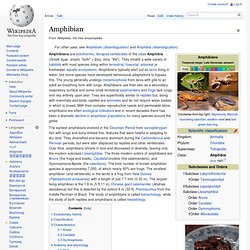

Amphibian. Evolutionary history[edit] Top: Restoration of Eusthenopteron, a fully aquatic lobe-finned fish Bottom: Restoration of Tiktaalik, an advanced tetrapodomorph fish The first major groups of amphibians developed in the Devonian period, around 370 million years ago, from lobe-finned fish similar to the modern coelacanth and lungfish,[2] which had evolved multi-jointed leg-like fins with digits that enabled them to crawl along the sea bottom.

Some fish had developed primitive lungs to help them breathe air when the stagnant pools of the Devonian swamps were low in oxygen. Tetrapod. While most species today are terrestrial, little evidence supports the idea that any of the earliest tetrapods could move about on land, as their limbs could not have held their midsections off the ground and the known trackways do not indicate they dragged their bellies around.

Presumably, the tracks were made by animals walking along the bottoms of shallow bodies of water.[2] Amphibians today generally remain semiaquatic, living the first stage of their lives as fish-like tadpoles. Several groups of tetrapods, such as the snakes and cetaceans, have lost some or all of their limbs. In addition, many tetrapods have returned to partially aquatic or fully aquatic lives throughout the history of the group (modern examples of fully aquatic tetrapods include cetaceans and sirenians). A quadruped actually uses four limbs for locomotion; not all tetrapods are quadrupeds.
Node.